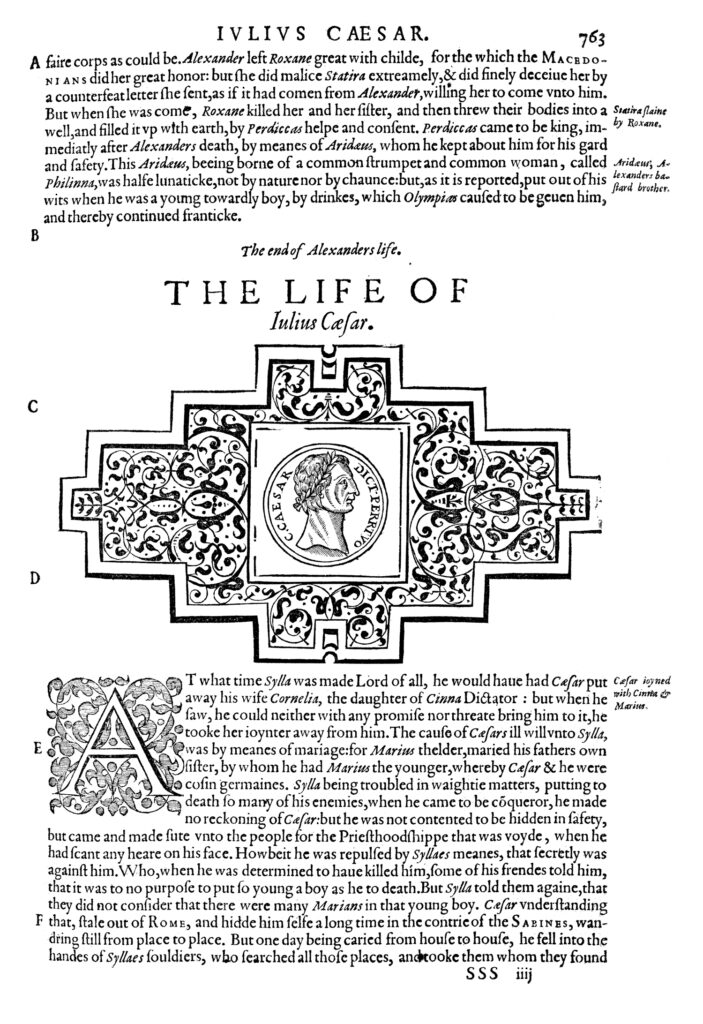By Barbara Mowat and Paul Werstine
Editors of the Folger Shakespeare Library Editions
Julius Caesar was first printed in the 1623 collection of Shakespeare’s plays now known as the First Folio. The present edition is based directly upon that printing.1 For the convenience of the reader, we have modernized the punctuation and the spelling of the Folio text. Sometimes we go so far as to modernize certain old forms of words; for example, usually when a means “he,” we change it to he; we change mo to more, ye to you, and god buy to you to good-bye to you. It is not our practice in editing any of the plays to modernize words that sound distinctly different from modern forms. For example, when the early printed texts read sith or apricocks or porpentine, we have not modernized to since, apricots, porcupine. When the forms an, and, or and if appear instead of the modern form if, we have reduced and to an but have not changed any of these forms to their modern equivalent, if. We also modernize and, where necessary, correct passages in foreign languages, unless an error in the early printed text can be reasonably explained as a joke.
Whenever we change the wording of the First Folio or add anything to its stage directions, we mark the change by enclosing it in superior half-brackets (⌜ ⌝). We want our readers to be immediately aware when we have intervened. (Only when we correct an obvious typographical error in the First Folio does the change not get marked.) Whenever we change either the First Folio’s wording or its punctuation so that meaning changes, we list the change in the textual notes, even if all we have done is fix an obvious error.
We correct or regularize a number of the proper names in the dialogue and in the stage directions, as is the usual practice in editions of the play. For example, the Folio’s spelling “Murellus” is changed to “Marullus”; the occasional appearance of “Antonio” in the Folio is regularized to “Antonius”; and there are a number of other comparable adjustments in the names. Since no scholars believe that the Folio Julius Caesar was printed directly from Shakespeare’s manuscript, it would be difficult to identify the Folio’s spellings of names as Shakespeare’s personal preferences.
This edition differs from many earlier ones in its efforts to aid the reader in imagining the play as a performance. Thus stage directions are written with reference to the stage. For example, at 3.1.13, instead of providing a stage direction that says, “Caesar goes into the Capitol,” we have offered something that can be presented on stage, “Caesar goes forward, the rest following.” Whenever it is reasonably certain, in our view, that a speech is accompanied by a particular action, we provide a stage direction describing the action. (Occasional exceptions to this rule occur when the action is so obvious that to add a stage direction would insult the reader.) Stage directions for the entrance of characters in mid-scene are, with rare exceptions, placed so that they immediately precede the characters’ participation in the scene, even though these entrances may appear somewhat earlier in the early printed texts. Whenever we move a stage direction, we record this change in the textual notes. Latin stage directions (e.g., Exeunt) are translated into English (e.g., They exit).
We expand the often severely abbreviated forms of names used as speech headings in early printed texts into the full names of the characters. We also regularize the speakers’ names in speech headings, using only a single designation for each character, even though the early printed texts sometimes use a variety of designations. Variations in the speech headings of the early printed texts are recorded in the textual notes.
In the present edition, as well, we mark with a dash any change of address within a speech, unless a stage direction intervenes. When the -ed ending of a word is to be pronounced, we mark it with an accent. Like editors for the past two centuries, we display metrically linked lines in the following way:
This, Decius Brutus.
BRUTUS He is welcome too.
(2.1.104–5)
However, when there are a number of short verse-lines that can be linked in more than one way, we do not, with rare exceptions, indent any of them.

From Plutarch, Lives of the Noble Grecians and Romanes … (1579).

